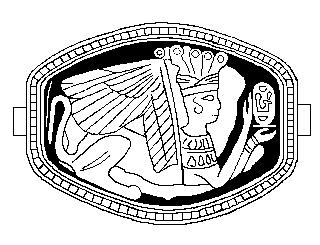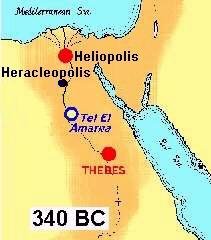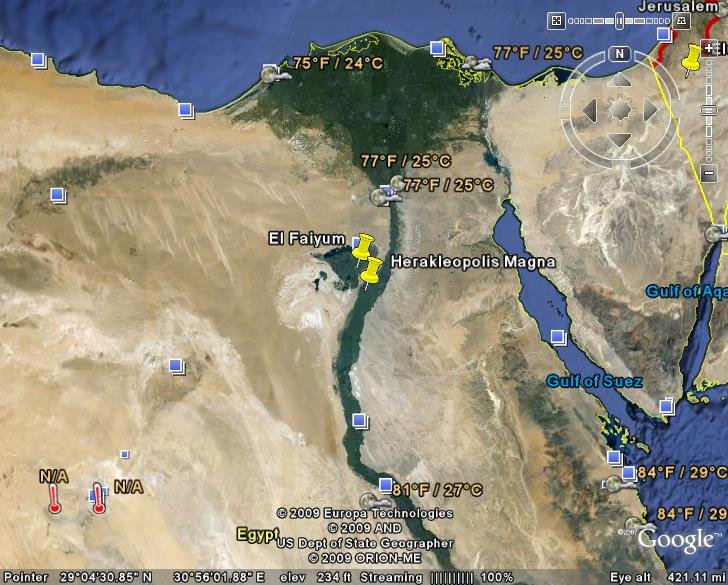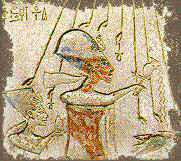
--Akhnaton--
Installed March 1998 - Latest Update, 10 Dec 2015
Text additons or changes are in bold.
|
In 1950 Immanuel Velikovsky published Worlds in Collision (Earth
and Venus, and later on Mars too, in close encounters of the worst kind);
followed by Ages in Chaos in 1952 (sliding a big chunk of ancient
Egyptian history, from the Exodus to Akhnaton, 600 years closer to us); and
Earth in Upheaval in 1955 (the geological record interpreted as
evidence of recent global catastrophes). It wasn't until 1960, however,
that he published Oedipus and Akhnaton(1) - (historical Oedipus
identified) which was the seminal work for the first three.
In the foreword to Oedipus and Akhnaton Velikovsky says: "Two decades ago ... I read Freud's last book, Moses and Monotheism(2), and was prompted to read more about Akhnaton, the real hero of that book. Soon I was struck by some close parallels between this Egyptian king and the legendary Oedipus." |
| When Moses and Monotheism (M.M.) was published, a number of scholars held that Egyptian Pharaoh Akhnaton (Amenhotep IV) was the world's first (royal) monotheist and that Moses, who lived at the same time, encouraged the Hebrews to adopt Akhnaton's religion. (This view hinges, in large part, on the supposition that the dating of Egyptian history is pretty much correct as currently portrayed.) |

--Akhnaton-- |
|
The following comments are made by psychoanalyst Dr. William Theaux
regarding Freud's handling (mostly non-handling) of Oedipus-Akhnaton
similarities.
"A major clue in Freud's case has been his inability to consider the similarities between Akhnaton and Oedipus. This similarity had been noticed by his disciple K. Abraham but was disregarded by Freud. ... When much later Freud published his 'Moses and Monotheism' he did not mention anything about the similarity between Akhnaton and Oedipus. Still today commentators wonder why and how he could have forgotten, repressed or deliberately omitted to mention K. Abraham and his thesis." (Dr. Theaux subscribes to the view that Oedipus=Akhnaton=Moses and that 1350 BC is a good date for all three.) In Moses and Monotheism Freud forced Galton's "average myth" formula onto his version of Moses. (The first part of this formula usually consists of having a royal infant banished and reared in secret by commoner parents.) Freud's primary list of heroes who fit the formula consisted of Sargon, Moses, Cyrus, and Romulus. His secondary list was "Oedipus, Karna, Paris, Telephos, Perseus, Heracles, Gilgamesh, Amphion, Zethros and others." (M.M. page 9) He admits that Moses' case is problematic but he makes things come out right by turning Moses into an Egyptian, "probably of noble origin," and lets myth finally turn him into a Jew. (M.M. page 13) He says "Only in the story of Oedipus is this difference [royal natural parents and commoner adoptive parents] obscured. The babe exposed by one kingly family is brought up by another royal pair." (M.M. page 10) Freud thus has Moses as being a high ranking Egyptian who was a devout adherent of Ikhnaton's monotheism. It was this Egyptian Moses, accompanied by a cadre of culturally superior Egyptians (Levites) who led his adopted Jewish nation out of Egypt. The rebellious "Jews" subsequently murdered him. (M.M. page 42) This killing of Moses, was deduced by Ernst Sellin (and apparently subscribed to by Freud) from a passage in the Old Testament book of Hosea. (This is probably Hosea 12:13-14.) To me, Moses and Monotheism reads like "stage setting" for the holocaust/shoah*. Indeed, in the very first sentence of Part I: Moses an Egyptian (Imago 1937) Freud says: "To deny a people the man whom it praises as the greatest of its sons is not a deed to be undertaken lightheartedly--especially by one belonging to that people. No consideration, however, will move me to set aside truth in favour of supposed national interests." *Shoah is a Hebrew word that means catastrophe. According to James Carroll, "Shoah, in its biblical usage, points to the absense of God's creative hovering, ..."(3) Freud confesses that he would have published the work many years earlier except he feared that the Roman catholic church would have stopped "protecting" him.
|

Queen Tiy as a winged sphynx. A Carnelian Cameo. (based on Metropolitan Museum of Art photograph) |
As Velikovsky dug into the Oedipus and Akhnaton background materials he found several problems that mitigated against a Thebes Greece origin for Oedipus and pointed rather in the direction of Thebes Egypt. The first of these was the female sphinx, "a winged maiden monster," who did a cameo appearance in the Greek tragedy. Sphinxes were not box office items in Greece but they were Standing Room Only in Egypt. Secondly, no convincing tombs or burial places for the participants in the supposedly Greek tragedy have been found. |
|
Velikovsky concludes that the Oedipus tragedy was in fact based on the historical Akhnaton but that Moses was not his disciple. By using large scale catastrophes as cross cultural time marks he dates Akhnaton some six centuries after the Hebrew exodus from Egypt. As a starting point in this process, he equates the plagues described in the Egyptian papyrus Admonitions of Ipuwer (conventionally time-wise smeared out between 2100-1800 BCE) with the plagues of the Exodus at about 1450 BCE. Akhnaton makes his entrance in about 850 BCE. This revised dating scheme comes to us in Velikovsky's Ages in Chaos series. In Oedipus Rex, the hero is a tragic innocent figure, fore-ordained to act out his unwitting patricide and subsequent incestuous marriage to his mother. In contrast to this "innocent victim" scenario, Velikovsky calls our attention to the idea that the historical Amenhotep IV (Akhnaton to be) was raised in exile, most likely with royal relatives in a region in or near Persia where ... mother-son incest was in vogue. Upon his return to Thebes Egypt, he knew that Queen Tiy (Kiya) was his mother but he suffered from a troublesome degree of political (and religious) incorrectness.
|
| In the Greek tragedy, Oedipus kills his father in a desolate region where three roads intersect. An intersection of three roads is rare. It might prove fruitful to check ancient maps of Egypt (and Greece) for such sites. Desert oases would fit the bill. Written records, inscriptons or folklore, from the right location, might add to our knowledge about the historical Oedipus. Two possible candidates in Egypt are the ancient cities of El Faiyum and Heracleopolis, which are about midway between El Amarna and Heliopolis. |

|
|
Google Earth shows a "confluence" of dirt roads at Heracleopolis (Herakleopolis Magna).
This could be a candidate locale for the "desolate region where three roads intersect."
Here is a series of "zooming in" space photos for this location. [Added 28 Aug 2011.]

When the Theban priests of Amon (Jupiter) frowned on Amenhotep IV's marriage to his mother, the recently widowed Queen Tiy, Amenhotep set an example for Henry VIII by starting his own church so-to-speak, substituting worship of Aton (the solar disk, according to Velikovsky), not monotheism, for that of Amon. Subsequently he did a routine for Constantine-the-Great to mimic and built a new religious capital, Akhet-Aton (el-Armarna), removed from unappreciative Egyptian holdouts. Getting back to Velikovsky's 600 year "leap to the future" for Egyptian history. Twenty years of his correspondence with academics and researchers in the fields of Egyptology and of radiocarbon dating, in trying to get tests done (and published) on artifacts from the 18th, 19th, and 20th dynasties, are summarized in a (1974) Penseé VI article titled ASH. Ransom(4) gives a Reader's Digest version of ASH. He mentions that Albert Einstein was about help find support for Velikovsky in trying to get carbon dating data released but he died suddenly (on the way to the mailbox so to speak). We can argue historical opinions and interpretations, including hidden psychological undercurrents, all we like, but once the radiocarbon dating results for Akhnaton's era finally gets out (last I heard, the data is still under wraps) there may be some significant reality adjustments in cross-cultural chronology in order.
|

|
Ransom(5) refers to Lewis M. Greenberg's suggestion that the worship of
Aton/Aten included that of Venus (in its original rôle as a comet)
to some degree. Greenberg asks, "Why was Aten represented with rays
emanating in arcuated fashion from one side only, as a comet's tail..., as
opposed to the standard portrayal of the sun's rays in a 360 degree sweep?"
and "...why does the Hymn to Aten say it 'rises like the living
Sun?' "(6) The fanning out rays of the Aten symbols shown in Velikovsky's
Oedipus and Akhnaton (six illustrations) subtend angles varying
from 30 to 80 degrees with 50 degrees being a rough average.
|
|
Postscript Velikovsky's research on Oedipus and Akhnaton, using Sophocles' Oedipus Rex as his primary source on Oedipus, began in the latter part of 1939. Within a year of this beginning, "sometime during the closing months of 1939 and most of 1940," a young Polish poet-thespian-scholar, Karol Wojtyla, amongst other literary pursuits, translated Oedipus Rex from the Greek into Polish(7). Velikovsky went on to become one of the world's most controversial individuals in the second half of the twentieth century. The Polish thespian went on to become Pope John Paul II.
References. (1) Immanuel Velikovsky, Oedipus and Akhnaton, Myth and History,, Doubleday, Garden City, New York, 1960. (Out of print. Limited availability.) (2) Sigmund Freud, Moses and Monotheism Translated from the German by Katherine Jones, Vintage Books, New York, 1939. (3) James Carroll, Constantine's Sword: The Church and The Jews, Houghton Mifflin Company, Boston - New York, 2001, p. 11. (4) C.J. Ransom, The Age of Velikovsky, Dell Publishing Co. New York, 1976, pp.164-174. (Out of print. Limited availabilty.). (5) C.J. Ransom, Op.cit., p. 256. (6) Lewis M. Greenberg, Pensée -- Immanuel Velikovsky Reconsidered, Volume I, p.41, May 1972. (This link takes you to a listing of Pensée issues and articles which are available in hard copy or on a CD from the Catastrophism website. (7) Tad Szulc, Pope John Paul II: The biography, Pocket Books, New York, 1996, p. 112.
Recommended Reading
[The link to a no longer online 2001 article Anti-Oedipus. Major Figures: Deleuze and Guattari,
|